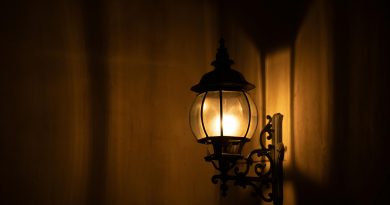Illuminate Your Night: Enhance Your Outdoor Space with Lighting
Outdoor lighting is an essential aspect of any outdoor space. It not only enhances the aesthetic appeal of your property but also provides safety and security. Whether you have a small patio or a sprawling backyard, outdoor lighting can transform your space into a welcoming and functional area for both daytime and nighttime use.
One of the key benefits of ckensu outdoor lighting is its ability to extend the usability of your outdoor space beyond daylight hours. With the right lighting, you can create a warm and inviting atmosphere that allows you to enjoy your outdoor area even after the sun goes down. Whether you’re hosting a dinner party or simply relaxing with a book, outdoor lighting can set the mood and create a cozy ambiance.
In addition to enhancing the aesthetics and functionality of your outdoor space, outdoor lighting also plays a crucial role in safety and security. Well-lit pathways, steps, and entrances can help prevent accidents and deter potential intruders. By illuminating dark areas around your property, you can create a sense of security and peace of mind.
Types of Outdoor Lighting: Choosing the Right Fit for Your Space
When it comes to outdoor lighting, there are various types to choose from, each serving a different purpose. Here are some popular options:
1. Floodlights: Floodlights are powerful lights that provide broad, intense illumination over a large area. They are commonly used for security purposes or to highlight specific features of your landscape.
2. Path lights: Path lights are low-level lights that are typically installed along walkways or driveways to provide guidance and safety at night. They come in various styles and designs to suit different aesthetics.
3. Step lights: Step lights are installed on staircases or steps to ensure visibility and prevent accidents. They can be recessed into the steps or mounted on the surface.
4. Deck lights: Deck lights are installed on decks or patios to provide ambient lighting and create a warm and inviting atmosphere. They can be mounted on the surface or recessed into the deck.
5. Wall lights: Wall lights are mounted on exterior walls and provide both functional and decorative lighting. They can be used to illuminate entrances, patios, or any other outdoor area.
6. String lights: String lights are a popular choice for creating a festive and whimsical atmosphere. They can be hung across trees, pergolas, or any other structure to add a touch of magic to your outdoor space.
7. Landscape lights: Landscape lights are used to highlight specific features of your landscape, such as trees, shrubs, or architectural elements. They come in various styles and can be placed in the ground or mounted on surfaces.
Planning Your Outdoor Lighting Layout: Tips and Tricks
Before you start installing outdoor lighting, it’s important to assess your space and create a lighting plan. Here are some tips to help you get started:
1. Assessing your space: Take a walk around your outdoor area and identify the areas that need lighting. Consider the purpose of each area and how you want it to be illuminated. Pay attention to potential hazards or dark spots that need extra lighting.
2. Creating a lighting plan: Once you have assessed your space, create a lighting plan that outlines where each type of lighting will be installed. Consider the placement of power sources and the wiring required for each fixture. Take into account the size and layout of your outdoor area to ensure proper coverage.
3. Choosing the right fixtures: When choosing fixtures, consider both functionality and aesthetics. Select fixtures that are suitable for outdoor use and can withstand the elements. Pay attention to the style and design of the fixtures to ensure they complement your outdoor space.
4. Considering energy efficiency: Opt for energy-efficient lighting options such as LED lights, which consume less energy and have a longer lifespan. Consider using timers or motion sensors to control the lighting and reduce energy consumption.
DIY vs. Professional Installation: Which is Right for You?
When it comes to installing outdoor lighting, you have the option to do it yourself or hire a professional. Here are some factors to consider when deciding:
1. Pros and cons of DIY installation: DIY installation can be cost-effective and allows you to have full control over the design and placement of your outdoor lighting. However, it requires some technical knowledge and skills, as well as the ability to handle electrical wiring safely. It can also be time-consuming, especially if you have a large outdoor area.
2. Pros and cons of professional installation: Professional installation ensures that the lighting is installed correctly and meets safety standards. It saves you time and effort, as the professionals have the necessary skills and equipment to complete the job efficiently. However, it can be more expensive than DIY installation, and you may have less control over the design and placement of the lighting.
3. Factors to consider when deciding: Consider your budget, time constraints, and level of expertise when deciding between DIY and professional installation. If you have a small outdoor area or limited budget, DIY installation may be a suitable option. However, if you have a large outdoor area or complex lighting requirements, professional installation may be worth considering.
Spotlight on Solar Lighting: Benefits and Drawbacks
Solar lighting has gained popularity in recent years due to its energy efficiency and ease of installation. Here are some advantages and disadvantages of solar lighting:
1. Advantages of solar lighting: Solar lighting is powered by sunlight, which means it doesn’t require electricity or wiring. It is easy to install and can be placed anywhere that receives sufficient sunlight. Solar lights are also energy-efficient and environmentally friendly, as they don’t contribute to greenhouse gas emissions.
2. Disadvantages of solar lighting: Solar lighting relies on sunlight to charge its batteries, which means it may not work effectively in areas with limited sunlight or during cloudy days. The brightness and duration of solar lights may also be affected by the quality of the batteries and solar panels. Additionally, solar lights tend to be more expensive upfront compared to traditional lighting options.
3. Choosing the right solar lighting for your space: When choosing solar lighting, consider the amount of sunlight your outdoor area receives and the specific lighting requirements. Opt for high-quality solar lights with efficient batteries and solar panels. Consider the brightness and duration of the lights to ensure they meet your needs.
Enhancing Safety and Security with Outdoor Lighting

Safety and security should be a top priority when it comes to outdoor lighting. Here are some tips for enhancing safety and security with outdoor lighting:
1. Importance of safety and security lighting: Well-lit pathways, steps, and entrances can help prevent accidents and injuries. Adequate lighting around your property can also deter potential intruders and provide a sense of security.
2. Types of safety and security lighting: Floodlights are commonly used for security purposes, as they provide broad, intense illumination over a large area. Motion sensor lights are another popular option, as they automatically turn on when they detect movement. Path lights and step lights can also enhance safety by providing guidance and visibility.
3. Placement and installation tips: Place safety and security lights strategically to ensure proper coverage. Install floodlights at key points around your property, such as entrances or dark corners. Place path lights along walkways or driveways to guide people safely. Install step lights on staircases or steps to prevent accidents. Consider using timers or motion sensors to control the lighting and conserve energy.
Creating Ambiance with Mood Lighting: Ideas and Inspiration
Mood lighting is all about creating a specific atmosphere or ambiance in your outdoor space. Here are some ideas for creating ambiance with lighting:
1. Importance of mood lighting: Mood lighting sets the tone for your outdoor space and creates a warm and inviting atmosphere. It can transform a plain patio into a cozy retreat or turn a backyard into a magical oasis.
2. Types of mood lighting: String lights are a popular choice for creating a romantic and whimsical ambiance. They can be hung across trees, pergolas, or any other structure to add a touch of magic to your outdoor space. Lanterns and candles are also great options for creating a cozy and intimate atmosphere.
3. Ideas for creating ambiance with lighting: Use string lights to create a canopy effect over your outdoor seating area. Hang lanterns or place candles on tables or along pathways to create a soft and romantic glow. Install dimmable lights to adjust the brightness and set the mood according to the occasion.
Highlighting Your Landscaping: The Art of Accent Lighting
Accent lighting is all about highlighting specific features of your landscaping, such as trees, shrubs, or architectural elements. Here are some tips for highlighting your landscaping with lighting:
1. Importance of accent lighting: Accent lighting adds depth and dimension to your outdoor space by drawing attention to specific areas or features. It can create focal points and enhance the overall aesthetics of your landscaping.
2. Types of accent lighting: Uplighting is a popular technique for accent lighting, where lights are placed at the base of trees or shrubs to illuminate them from below. Downlighting involves placing lights above the feature to create a spotlight effect. Silhouetting is another technique where lights are placed behind the feature to create a dramatic silhouette.
3. Tips for highlighting your landscaping with lighting: Choose fixtures that are suitable for outdoor use and can withstand the elements. Experiment with different angles and positions to achieve the desired effect. Consider using colored filters or lenses to add an extra layer of drama to your accent lighting.
Maximizing Functionality with Task Lighting
Task lighting is all about providing focused illumination for specific tasks or activities in your outdoor space. Here are some tips for maximizing functionality with lighting:
1. Importance of task lighting: Task lighting ensures that you have adequate illumination for activities such as cooking, reading, or working in your outdoor space. It enhances functionality and allows you to use your outdoor area for various purposes.
2. Types of task lighting: Under-cabinet lights are commonly used for task lighting in outdoor kitchens or cooking areas. Adjustable spotlights or wall-mounted lights can provide focused illumination for reading or working areas. Task lights can also be installed above work surfaces or tables to provide direct lighting.
3. Tips for maximizing functionality with lighting: Consider the specific tasks or activities that will take place in your outdoor space and plan the lighting accordingly. Install task lights at the appropriate height and angle to ensure proper illumination. Use dimmable lights to adjust the brightness according to the task at hand.
Maintaining Your Outdoor Lighting: Tips for Longevity and Efficiency
Proper maintenance is essential to ensure the longevity and efficiency of your outdoor lighting. Here are some tips for maintaining your outdoor lighting:
1. Importance of maintenance: Regular maintenance helps prevent issues such as bulb burnouts, wiring problems, or water damage. It ensures that your outdoor lighting continues to function properly and provides the desired illumination.
2. Tips for maintaining your outdoor lighting: Clean the fixtures regularly to remove dirt, debris, or insects that may affect the performance of the lights. Replace burnt-out bulbs promptly to maintain consistent illumination. Inspect the wiring periodically for any signs of damage or wear and tear. Check the connections and tighten any loose screws or fittings.
3. Tips for improving energy efficiency: Consider using energy-efficient bulbs such as LED lights, which consume less energy and have a longer lifespan. Use timers or motion sensors to control the lighting and reduce energy consumption. Consider installing solar lights in areas that receive sufficient sunlight to further reduce energy usage.
Outdoor lighting is a crucial aspect of any outdoor space, providing both aesthetic appeal and functionality. It enhances the usability of your outdoor area, creates a warm and inviting atmosphere, and ensures safety and security. With various types of lighting available, such as floodlights, path lights, and string lights, you can choose the right fit for your space and specific needs.
When planning your outdoor lighting layout, assess your space, create a lighting plan, choose the right fixtures, and consider energy efficiency. You can either opt for DIY installation or hire a professional, depending on your budget and level of expertise. Solar lighting is a popular option due to its energy efficiency and ease of installation.
Enhancing safety and security with outdoor lighting is essential. Use floodlights, motion sensor lights, path lights, and step lights strategically to ensure proper coverage. Mood lighting can create a specific ambiance in your outdoor space, while accent lighting highlights specific features of your landscaping. Task lighting maximizes functionality by providing focused illumination for specific tasks or activities.
Proper maintenance is crucial to ensure the longevity and efficiency of your outdoor lighting. Clean the fixtures regularly, replace burnt-out bulbs promptly, inspect the wiring periodically, and consider using energy-efficient options. By considering outdoor lighting as a way to enhance your outdoor space, you can create a welcoming and functional area that you can enjoy day and night.



